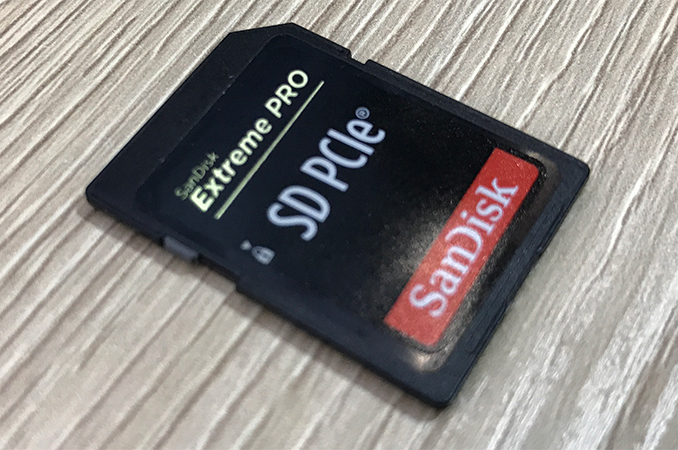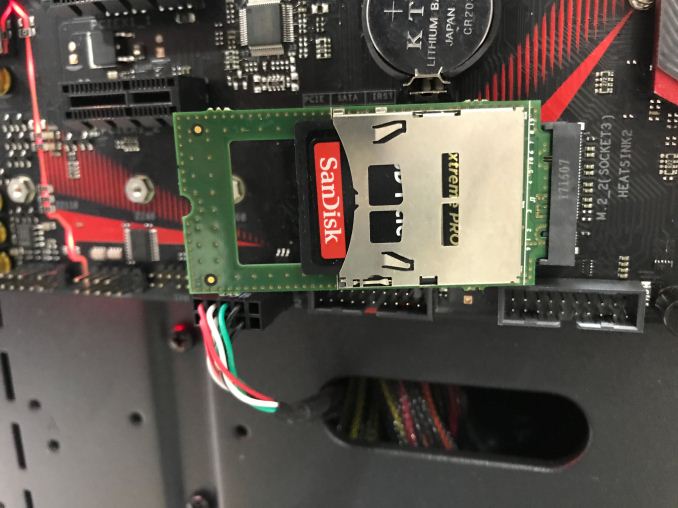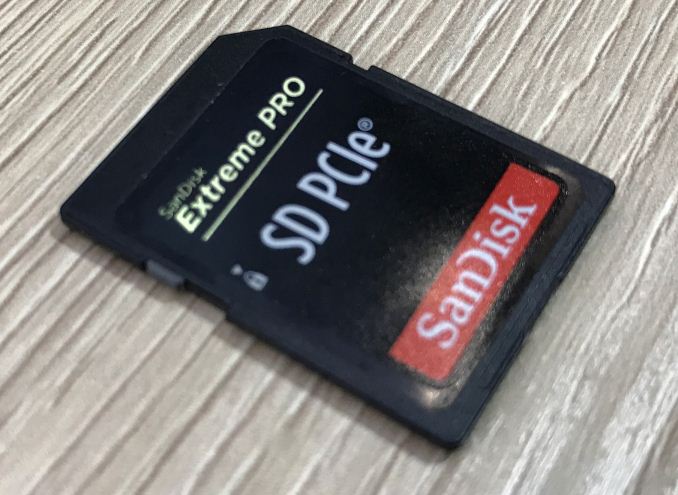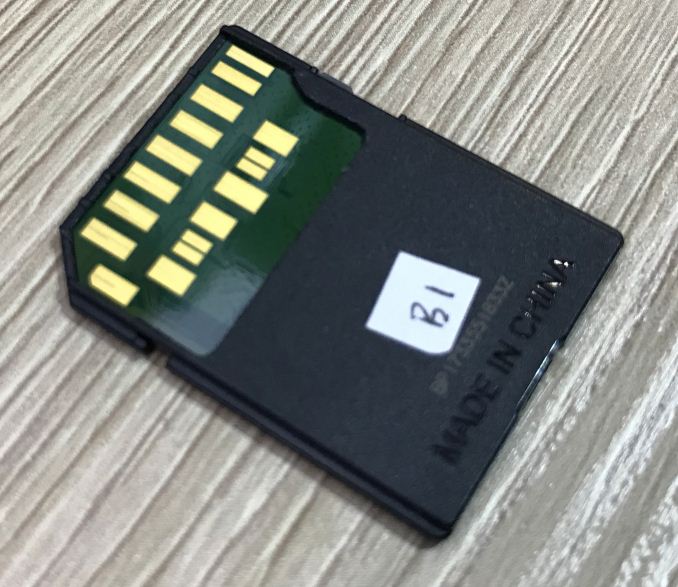PCIe-Based SD 7.0 Spec Closing In, Set to Be Announced This Month
by Anton Shilov on June 12, 2018 11:00 AM EST- Posted in
- SD cards
- Trade Shows
- Memory Cards
- PCIe
- Computex 2018

The SD Association plans to formally announce its Secure Digital 7.0 specification later this month. The new spec will define usage of a PCIe protocol for SD cards and will therefore significantly increase performance compared to existing cards that use the UHS-I or UHS-II buses.
Earlier this year Western Digital demonstrated a prototype SD card featuring a PCIe 3.0 x1 interface, whereas the SD Association announced plans to standardize usage of PCI Express on SD cards. As it turns out, SDA is accelerating its PCIe with SD effort and will formally announce publication of the spec at this year’s MWC Shanghai that takes place on June 26 – June 28.
Details regarding the spec are unknown at this point. Meanwhile Western Digital’s implementation demonstrated at MWC used the existing UHS-II/III pins to construct a PCIe 3.0 x1 interface with the host and probably standard PCIe voltage with a converter. The card offered 880 MB/s sequential read speeds as well as up to 430 MB/s sequential write speeds, according to the CrystalDiskMark benchmark, which is considerably higher compared to cards featuring the UHS-II bus (up to 312 MB/s full duplex), and about 40% higher when compared to cards featuring the UHS-III bus (up to 624 MB/s full duplex).
Usage of a PCIe protocol will solve a number of performance-related challenges for the SD standard in general but will create new ones too. Firstly, it will enable SD cards to increase their performance and will ensure a steady and straightforward path for performance upgrades in the future. Secondly, it will simplify implementation of high-performance SD card readers on PCs and similar devices that run chips that already support PCIe. In theory, PCIe might enable the SD technology to go beyond cards and into highly-integrated storage modules (like eMMC, UFS, etc.) for various applications. However, there will be challenges too: PCIe is not exactly power efficient (this might change with PCIe 4.0 though), PCIe is not supported by most smartphone/camera SoCs because of power and some other factors. Moreover, the SDA wants PCIe-based SD cards (and probably hosts) to be backward compatible, which means additional complications.
In any case, the aforementioned are just theoretical effects a PCIe interface could bring to the SD world. The formal announcement is just weeks away, so we will learn all the information shortly from now.
| Want to keep up to date with all of our Computex 2018 Coverage? | ||||||
 Laptops |
 Hardware |
 Chips |
||||
| Follow AnandTech's breaking news here! | ||||||













15 Comments
View All Comments
PeachNCream - Tuesday, June 12, 2018 - link
This is good news for the eventual improvement in budget computers that have been recently relying on eMMC flash for the past few years.Alexvrb - Tuesday, June 12, 2018 - link
I mean... computers can already use M.2 or embedded PCIe solutions. They were literally only using eMMC because it's cheaper than any PCIe solution. The advent of PCIe SD cards won't change that... they'll continue to use eMMC for super budget flash until they stop making it or the price differential shrinks to zero. Both of those will take a while.SigmundEXactos - Tuesday, June 12, 2018 - link
And....XQD and CFast are now dead.spaceship9876 - Tuesday, June 12, 2018 - link
Cfast isn't dead, the cards are much more physically robust which is important for camera manufacturers and directors. Movie cameras would just use 2.5" ssd's if they wanted speed, they created cfast because they wanted a much more rugged product that was also smaller than a 2.5" ssd.benzosaurus - Wednesday, June 13, 2018 - link
The Red One originally used a RAID0 of two 2.5" *hard drives*. So, um, yeah. Physical volume is not a thing they care about.xype - Wednesday, June 13, 2018 - link
Just because they used two 2.5" drives in the Red One that does not mean that camera manufacturers and directors didn’t want something smaller and more robust. It’s like saying people didn’t want thinner and lighter laptops because they used thick and heavy ones before.Lord of the Bored - Friday, June 15, 2018 - link
Laptops? Computers used to be the size of ROOMS, people don't want laptops.Spunjji - Wednesday, June 13, 2018 - link
I don't think they're more robust than SD cards. Larger, sure, but no more or less resilient to heat, shock etc. "They" created CFAST in 2009 because CompactFlash was still using the old parallel ATA interface and it was a natural progression to SATA instead; it doesn't really have anything to do with the comparative size of SSDs other than that obviously they weren't going to make the standard larger than the outgoing one.Duncan Macdonald - Tuesday, June 12, 2018 - link
Even the 430MB/sec writing rate is not up to handling 4Kp60 HDR RAW (a bit over 600MB/sec) or RGB (over 1800 MB/sec). (RAW data rate is lower as the Bayer filter processing is left to later so each pixel has one 10 bit number - not the three RGB 10 bit numbers.)At the moment virtually all 4K camcorders use lossy encoding to keep the data rates and storage requirements down to something acceptable.
spaceship9876 - Tuesday, June 12, 2018 - link
Anandtech, please ask Samsung what is happening with Micro UFS cards, they announced them 2yrs ago but they haven't gone on sale. They are faster than ssd in terms of sustained speeds and iops, they also use less power than sd.